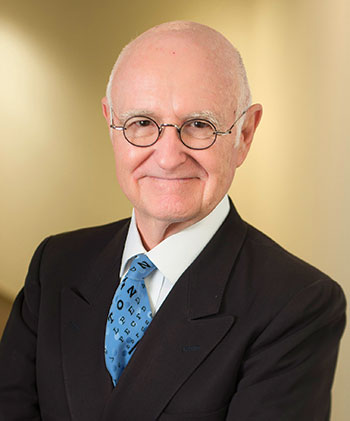 |
|
Photo by Steve Barrett Joe Powell, founder and executive director of the new Academy for Healthcare Infrastructure |
As founder and executive director of the new Academy for Healthcare Infrastructure, Joe M. Powell will oversee a select group of health care facility professionals who are researching how hospital infrastructure can serve patients and staff better.
Why was the Academy for Healthcare Infrastructure (AHI) formed?
The Academy was formed at the request of several major American health care systems that are committed to making the built environment work more effectively.
Almost all current health care management strategies have a facility component. The buildings can facilitate the execution of corporate missions or get in the way; usually, buildings slow progress. Our job is to advance the design and construction process so that it furthers the execution of health care delivery.
Who has the most important role in the development of health care facilities and related infrastructure?
To shape today’s incredibly complex health care infrastructure, large, integrated teams of experts are required. But our work tells us that, in the long run, the single most powerful role in the process belongs to the owner. At the end of the day, the owner has the most to gain from a successful project and the most to lose when solutions are inadequate.
Each of five research teams of health care facility industry experts assembled by AHI produced a white paper on an issue impacting infrastructure. How did you assemble the teams and determine the focus of each white paper?
The first program initiated by the Academy is the 2015 White Paper Program, which brings together 48 of the industry’s most impactful leaders organized around five issues considered critical to health care facilities.
We interviewed executives from 25 private health care systems and two federal agencies to identify 10 issues considered critical to the advancement of health care infrastructure. Of those 10, five issues were selected to receive attention through a “best current thinking” process.
Each of the five topics was the focus of one Interdisciplinary Research Team. All teams were chaired by four current upper management executives from 20 of the nation’s largest health care systems along with the Department of Defense’s Defense Health Agency. The owner co-chairs then selected four to eight subject matter experts.
One area for research is the design and construction process and improving speed to market. Why is this a problem and how can it be fixed?
Current design and construction processes take too long. Although the design and construction industry is the primary entity responsible for delivering health care facilities, it is the owner who has the majority of control over speed-to-market outcomes.
The past, somewhat singular metric of how quickly a project can be designed and constructed, is now how quickly health care and services can be provided.
Owner and industry definitions vary from the time an idea has been expressed to the time when services are provided to when a requirement has been memorialized and contracts signed.
Reducing initial capital costs also was identified as an area of research. Why?
The American health care system is now challenged to heal more patients with fewer resources. The built environment for health care must respond by being more supportive and costing less.
The Powell File |
CV• Founder and executive director, Academy for Healthcare Infrastructure — a program of the National Institute of Building Sciences • The Rice Building Institute/Rice University, founder and executive director • Worthing Brighton Management Research, founder • CAD Management Corp., founder • Planning Design Research Corp., founder • Registered architect, Texas Board of Architectural Examiners ACCOMPLISHMENTS• Author of books covering such topics as health care facility project delivery; the rise to prominence of the largest international architecture, engineering and construction firms; and developing effective corporate business strategies • Served as project executive on numerous research programs related to health care facility projects delivery in the private sector and by the Department of Defense, and also headed up field research on business organizational strategies • Received Alpha Rho Chi Medal for demonstrating leadership and service while in the school of architecture at Texas A&M University EDUCATION• Master of architecture, Texas A&M University • Bachelor of environmental design, Texas A&M University |
The research team focused on 12 major points, including evaluating capital costs based on life cycle and best value, operational efficiency, how to Lean existing processes first, concentrating on the patient experience, managing real estate as a valued asset and how to use programming to drive development budgets.
Other topics covered include how to address needs, not wants; how to select project team members based on fit, understanding and qualifications; how to utilize performance contracting; developing standards; leveraging technology; how to utilize prefabrication and modularization; and how to leverage purchasing power.
Why is developing a flexible health care infrastructure important to research?
American health care is experiencing unprecedented uncertainty. Infrastructure must effectively respond. This team has dealt with drivers for change, dimensions of change, locations and scope of change in health care, concepts and best practices, and recommendations and limitations.
One research team was asked to address important issues facing design and construction of the next generation of health care facilities. How will they differ from today’s facilities?
This collaborative research program is designed to focus on issues that are critical to our industry’s performance. We must avoid, however, the temptation to repeatedly address the same issues.
Instead, we need to explore the questions the next generation should be asking. On what issues should the next generation focus?
This team dealt with the future integration of technology, costs, decentralization of services and the evolution of the continuum of care. Future leaders and executives must address greater tolerance for ambiguity, awareness of technology, and the ability to simultaneously generalize and specialize.
What does AHI plan to do with the information generated through the research for the white papers?
All five white papers will be published on the National Institute of Building Sciences (NIBS) and AHI website and can be downloaded at will. Each of the five teams was scheduled to present its findings at the NIBS national event in Washington, D.C., last month.
What are the future plans for AHI?
The white paper program for 2015 has proven to be successful, so it will be repeated every year. In addition, we intend to develop more programs for 2016.
The single most accurate predictor of success in any complex human undertaking is the level and effectiveness of professional collaboration that exists among the team of experts tackling the problem.
By launching an awards program, the Academy will recognize project teams that have successfully integrated their work and produced superior outcomes.
The Academy has found that the best way for health care facility industry leaders to learn is from each other. In 2016, industry executives will be placed in groups with other companies that are similarly constituted through an Industry Governor’s program.
Each group not only will learn from each other, but also will be exposed to executives from other industries who have wrestled with comparable problems. As an example, in the past, we have utilized wisdom from NASA, Walt Disney Imagineering and Boeing.
One of the issues that always gains a great deal of traction is the impact of the built environment on the development and execution of corporate strategy. To further this concept, we are developing a series of programs called Health Care C-Suite Joint Ventures.
Jeff Ferenc is a senior editor of Health Facilities Management.





